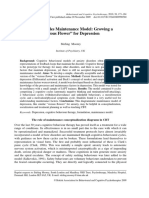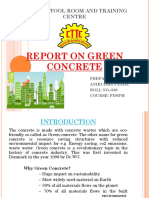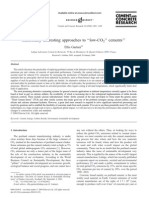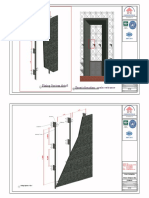What Is Green Concrete?: April 2009
What Is Green Concrete?: April 2009
Uploaded by
Khaled Abdel SalamCopyright:
Available Formats
What Is Green Concrete?: April 2009
What Is Green Concrete?: April 2009
Uploaded by
Khaled Abdel SalamOriginal Title
Copyright
Available Formats
Share this document
Did you find this document useful?
Is this content inappropriate?
Copyright:
Available Formats
What Is Green Concrete?: April 2009
What Is Green Concrete?: April 2009
Uploaded by
Khaled Abdel SalamCopyright:
Available Formats
See discussions, stats, and author profiles for this publication at: https://www.researchgate.
net/publication/237701866
What is Green Concrete?
Article · April 2009
CITATIONS READS
34 3,971
1 author:
Karthik Obla
National Ready Mixed Concrete Association, Silver Spring, MD
70 PUBLICATIONS 1,105 CITATIONS
SEE PROFILE
Some of the authors of this publication are also working on these related projects:
Sustainability View project
Fiber Reinforced Concrete View project
All content following this page was uploaded by Karthik Obla on 11 August 2017.
The user has requested enhancement of the downloaded file.
Point of View
These columns of ICJ offer an opportunity to the engineering
fraternity to express their views on the current practices in
design, construction and management being followed in the
industry.
To share your opinion with our readers, you may send in your
inputs in about 1500 words via e-mail to editor@icjonline.com
What is Green Concrete?
Karthik H. Obla
Engineers and architects have choices of the material and which environmental impact indicator is most important.
products they use to design projects – when it comes to a And often times conducting a full LCA is so complex
building frame the choice is typically between concrete, that only a partial LCA is conducted with a focus on one
steel and wood; for paving applications the choice is or two phases of the life cycle. Recent focus on climate
generally between concrete and asphalt. Material choice change and the impact of greenhouse gas emissions
depends on several factors including first cost, life cycle on our environment has caused many to focus on CO2
cost and performance for a specific application. Due to emissions as the most critical environmental impact
growing interest in sustainable development engineers indicator. The problem with this approach is that it forces
and architects are motivated more than ever before to engineers, architects and product manufacturers to focus
choose materials that are more sustainable. However their efforts on reducing greenhouse gas emissions
this is not as straight forward as selecting an energy without regard to other sustainable practices.
star rated appliance or a vehicle providing high gas
mileage.1 On what “measurement” basis can engineers
and architects compare materials and choose one that
Concrete and CO2
is more sustainable or specify a material in such a way Every 1 ton of cement produced leads to about 0.9 tons
as to minimize environmental impact? of CO2 emissions and a typical cubic yard (0.7643 m3) of
concrete contains about 10% by weight of cement.4 There
Life Cycle Assessment (LCA) seems to offer a solution. have been a number of articles written about reducing
LCA considers materials over the course of their entire the CO2 emissions from concrete primarily through the
life cycle including material extraction, manufacturing, use of lower amounts of cement and higher amounts of
construction, operations, and finally reuse/recycling. supplementary cementitious material (SCM) such as fly
LCA takes into account a full range of environmental ash and slag. Table 1 has been developed based on data
impact indicators—including embodied energy, air presented by Marceau et al.5
and water pollution (including greenhouse gases),
potable water consumption, solid waste and recycled The following observations can be made:
content. just to name a few. Building rating systems
such as LEED and Green Globes, are in various stages of Since a cubic yard of concrete weighs about 2 tons, CO2
incorporating LCA so that they can help engineers and emissions from 1 ton of concrete varies between 0.05 to
architects select materials based on their environmental 0.13 tons.
performance or specify materials in such a way as to
minimize environmental impact.2,3 Approximately 95% of all CO2 emissions from a cubic
yard of concrete is from cement manufacturing and so it
One potential drawback of LCA however is that the is no wonder that much attention is paid to using greater
person conducting the analysis often has discretion to set amounts of SCM.
26 The Indian Concrete Journal APRIL 2009
Point of View
+
Table 1. Total CO2 emissions for 1 cubic yard (yd3) of concrete for different strength classes and mixture
proportions5
Ready Strength class, Mixture proportions*, Total concrete Breakdown of CO2 Emissions for 1 yd3,%
mix psi (kgf/cm2) lb/yd3 (kg/m3) CO2 emission, (0.76455 m3)
Id lb/yd3 (kg/m3)
Cement SCM Aggregate Plant Transport#
operations
1 5000 (351) 564/0/0 528 (313) 96.8% 0.0% 0.6% 0.6% 2.0%
(335/0/0)
2 4000 (281) 470/0/0 442 (262) 96.3% 0.0% 0.7% 0.7% 2.3%
(279/0/0)
3 3000 (210) 376/0/0 355 (211) 95.7% 0.0% 0.9% 0.8% 2.6%
(223/0/0)
4 3000 (210) 301/75/0 288 (171) 94.6% 0.0% 1.1% 1.0% 3.2%
(179/44/0)
5 3000 (210) 282/94/0 270 (160) 94.3% 0.0% 1.2% 1.1% 3.4%
(167/56/0)
6 3000 (210) 244/0/132 239 (142) 92.4% 1.2% 1.4% 1.2% 3.9%
(145/0/78)
7 3000 (210) 188/0/188 189 (112) 89.8% 2.1% 1.7% 1.6% 4.9%
(111/0/111)
*564/0/0 signifies that the mixture contains 564 lb/yd3 cement, 0 lb/yd3 fly ash, 0 lb/yd3 slag cement
#
Transport costs is for material shipped to ready mix plant
+
1 yd3 = 0.76455 m3
However, focusing entirely on CO2 emissions will result water and instead specify water according to
in the following unintended consequences: ASTM C1602 which allows non potable water and
water from ready mixed concrete operations as
1. Does not encourage the use of recycled or long as concrete performance data is maintained
crushed returned concrete aggregates since use of and met.6
virgin aggregates constitutes only 1% of all CO2
emissions from a typical cubic yard of concrete. 3. Does not encourage the use of sustainable practices
Even replacing all virgin aggregates with such as energy savings at a ready mixed concrete
recycled aggregates will reduce CO2 emissions plant since CO2 emissions from plant operations
by only 1%. But the use of recycled aggregates is constitutes only 1% of all CO2 emissions from a
important as it can reduce landfills and support cubic yard of concrete.
sustainable development. So, there is a need to
incentivise its use. Several local governments are 4. Does not encourage the use of sustainable
requiring less land filling and making land filling practices such as energy savings during transport
more expensive. Also prescriptive specification of the materials to the ready mixed concrete plant
restrictions on the use of recycled aggregates since CO2 emissions from transport constitutes
should be removed. Focus on performance will only about 3% of all CO2 emissions from a cubic
encourage producers to recycle. yard of concrete.
2. Does not encourage the use of water from As discussed earlier LCA considers materials over the
ready mixed concrete operations (water used course of their entire life cycle – material acquisition,
for cleaning ready mixed concrete trucks, and manufacturing, construction, operation, and reuse/
precipitation at a plant) since use of mixing water recycling. However, partial LCA may focus on CO2
constitutes a negligible amount (<< 1%) of all CO2 emissions on the material acquisition and manufacturing
emissions from a typical cubic yard of concrete. stage. It does not address the Construction, Operation,
Use of recycled water should be encouraged since and Reuse/Recycling portions of the LCA. Operationally
fresh water is becomingly increasingly scarce. This concrete is a very sustainable material – it has several
can be accomplished by removing specification advantages such as long term durability, high solar
restrictions that require the use of only potable reflectivity (lower heat island effect), and high thermal
APRIL 2009 The Indian Concrete Journal 27
Point of View
mass (lowers energy consumption). It is almost entirely (for example a steel frame building or an asphalt
recyclable. It can absorb CO2 from the atmosphere roadway).
during its service life and after it is crushed for recycling.
It can be used in applications such as pervious concrete 4. Focusing solely on CO2 emissions from cement
that can reduce storm water runoff and recharge ground and concrete production does not encourage
water. the use of recycled or crushed returned concrete
aggregates; use of water from ready mixed
It is important to keep a holistic cradle to cradle concrete operations; use of sustainable practices
perspective when it comes to the use of a material. Based such as energy savings at a ready mixed concrete
on research Gajda et al.7 concluded that occupant energy- plant and use of sustainable transport practices.
use accounts for 99% of life cycle energy use of a single This is because only 5% of CO2 emissions from
family home. Less than 1% of the life cycle energy used a cubic yard of concrete is due to use of virgin
in that home was due to manufacturing cement and aggregates, water, plant operations and material
producing concrete. When taken as a whole the U.S. transport to the plant.
cement industry accounts for approximately 1.5% of U.S.
CO2 emissions. The global cement industry accounts for 5. Removal of prescriptive specification restrictions
approximately 5% of global CO2 emissions.8 So whatever and focusing on performance and the use of
way one looks at it focusing on just the production of incentives is an effective way to encourage
concrete accounts for a very small percent of overall CO2 sustainable concrete with low CO2 emissions.
emissions. This is not to say that progress should not
be made in reducing the CO2 emissions from concrete References
as produced. However one should keep in mind that 1. http://www.energystar.gov/
whatever CO2 emission reductions that are possible 2. Leadership in Energy and Environmental Design (LEED), U.S. Green
Building Council, Washington, DC, http://www.usgbc.org/
will still account for at best a 2% global CO2 reduction
3. Green Globes, The Green Building Initiative, Portland, Oregon, http://www.
(assuming a challenging 40% reduction in global CO2 thegbi.org/
emissions from cement manufacture from now on). 4. Concrete CO2 Fact Sheet, 2PCO2, 13 pp., June 2008, National Ready Mixed
Concrete Association, Silver Spring, MD, www.nrmca.org
5. Medgar L. Marceau, Michael A. Nisbet, and Martha G. VanGeem, Life
Summary Cycle Inventory of Portland Cement Concrete, SN3011, Portland Cement
Association, Skokie, IL, PCA, 2002, www.cement.org
1. CO2 emissions from 1 ton of concrete produced
6. ASTM C1602 / C1602M - 06 Standard Specification for Mixing Water Used in
vary between 0.05 to 0.13 tons. 95% of all CO2 the Production of Hydraulic Cement Concrete, American Society of Testing
emissions from a cubic yard of concrete is from Materials, Volume 4.02, www.astm.org.
cement manufacturing. It is important to reduce 7. Gajda, John, Van Geem, Martha G., and Marceau, Medgar L., Environmental
Life Cycle Inventory of Single Family Housing, SN2582a, Portland Cement
CO2 emissions through the greater use of SCM. Association, Skokie, IL, PCA, 2002, www.cement.org
8. Ernst Worrell, Lynn Price, C. Hendricks, L. Ozawa Meida, Carbon Dioxide
2. It is important not to focus solely on CO 2 Emissions from the Global Cement Industry, Annual Review of Energy and
emissions from cement and concrete production. Environment, Vol. 26, 2001 http://industrial-energy.lbl.gov/node/1930
Doing so limits the total global CO2 reduction
possible to at best 2%. Keeping a holistic cradle
to cradle perspective and using LCA can help Dr. Karthik Obla, P.E., received his Ph.D. in
reduce CO2 by a much greater amount since civil engineering from University of Michigan,
there is evidence to show that most of the energy Ann Arbor and is a licensed professional
engineer in the state of Michigan and Maryland.
is consumed during the operational phase of the Presently, he is the managing director, Research
structure (heating and cooling). Concrete is very and Materials Engineering at the National Ready
effective in reducing energy consumption due to Mixed Concrete Association (NRMCA). He has
its high solar reflectivity, and high thermal mass over 18 years of experience in concrete materials technology
and research and has interests in mixture proportioning,
among other benefits. durability, quality control, specifications, and the use of
recycled materials. He is a Fellow of ACI and a winner of
3. Focusing solely on CO2 emissions from cement ACI’s Young Professional Achievement Award. Dr. Obla is
and concrete production increases the perception an active member of various ACI, ASTM, and TRB technical
committees and serves as Chair for ASTM C09.49 – Pervious
that concrete is not sustainable which is inaccurate
Concrete and ACI 232 – Fly ash. He served as Vice-President
since operationally concrete has substantial and President for the ACI San Antonio Chapter. Prior to
sustainability benefits. An incorrect perception joining NRMCA in 2003 he was technical manager at Boral
can lead to a less sustainable material choice Material Technologies for several years.
28 The Indian Concrete Journal APRIL 2009
View publication stats
You might also like
- Csi Refer SAP2000Document550 pagesCsi Refer SAP2000Taylor Fuentes100% (2)
- The Six Cycles Maintenance Model Growing A Vicious Flower For DepressionDocument12 pagesThe Six Cycles Maintenance Model Growing A Vicious Flower For DepressionDIANA SPRINCEANUNo ratings yet
- Appendix A-Trace File Catalog-Needs SelectionDocument16 pagesAppendix A-Trace File Catalog-Needs SelectionnalpsaNo ratings yet
- 2009ICJGREENDocument4 pages2009ICJGREENcibif40663No ratings yet
- What Is Green Concrete PDFDocument3 pagesWhat Is Green Concrete PDFVelchuri SairamNo ratings yet
- Green Concrete and Sustainability of Environmental System - Yash KrishiDocument8 pagesGreen Concrete and Sustainability of Environmental System - Yash KrishiSree NivasNo ratings yet
- Effects On Compressive Strength When Cement Is Partially Replaced by Fly-AshDocument10 pagesEffects On Compressive Strength When Cement Is Partially Replaced by Fly-AshInternational Organization of Scientific Research (IOSR)No ratings yet
- Green 070415Document52 pagesGreen 070415tcthomasNo ratings yet
- Building A Green Swimming Pool by Using Concrete With Aggregates From Demolition WasteDocument4 pagesBuilding A Green Swimming Pool by Using Concrete With Aggregates From Demolition WasteSoewignjo Agus NugrohoNo ratings yet
- Improving The CO2 Performance of CementDocument10 pagesImproving The CO2 Performance of CementRanganathan ThambirajanNo ratings yet
- Firdous Et Al-2022-Journal of Materials ScienceDocument15 pagesFirdous Et Al-2022-Journal of Materials ScienceHemin ZZNo ratings yet
- Green ConcreteDocument22 pagesGreen ConcreteSyafiq ArtNo ratings yet
- 2018 Evaluation of Environmental Impact Distribution Methods For Supplementary Cementitious MaterialsDocument12 pages2018 Evaluation of Environmental Impact Distribution Methods For Supplementary Cementitious MaterialsTiago BragaNo ratings yet
- Ige 2021 A Review of The Effectiveness of Life Cycle Assessment For GaugingDocument12 pagesIge 2021 A Review of The Effectiveness of Life Cycle Assessment For Gaugingabhiramshukla.civil.nitrr.2017No ratings yet
- Eco Concrete Opportunities and ChallengesDocument22 pagesEco Concrete Opportunities and ChallengesVinay Gupta100% (1)
- Innovations in Chemical Admixture Technology As Related To Sustainability, Part 2Document9 pagesInnovations in Chemical Admixture Technology As Related To Sustainability, Part 2masteriragaNo ratings yet
- Recycling of High Volumes of Cement Kiln Dust in Bricks IndustryDocument10 pagesRecycling of High Volumes of Cement Kiln Dust in Bricks IndustryAnonymous NxpnI6jCNo ratings yet
- Flower-Sanjayan2007 Article GreenHouseGasEmissionsDueToConDocument7 pagesFlower-Sanjayan2007 Article GreenHouseGasEmissionsDueToConVinayaka Ram VNo ratings yet
- DR - Mohamed Ali-Leeds Univ. PresentationDocument9 pagesDR - Mohamed Ali-Leeds Univ. PresentationDr. Mohamed AliNo ratings yet
- Green Concrete: WWW - SeminarDocument12 pagesGreen Concrete: WWW - SeminarSuraj Deb BarmaNo ratings yet
- Ali Sarmah STOTENPaper2017Document10 pagesAli Sarmah STOTENPaper2017Terry McManamanNo ratings yet
- 06 Assessmentof CO2 EmissionsandcostinflyashconcreteDocument5 pages06 Assessmentof CO2 EmissionsandcostinflyashconcreteshifatNo ratings yet
- Green ConcreteDocument12 pagesGreen Concretevaishnavi yedur100% (1)
- ARUP Embodied Carbon Concrete 1Document17 pagesARUP Embodied Carbon Concrete 1Gabriel MacaulayNo ratings yet
- Wimala, Fujiki, Kawai - 2011 - Environmental Impact of Waste Concrete Treatment in Precast Concrete Production - Proceedings of The AnnuDocument7 pagesWimala, Fujiki, Kawai - 2011 - Environmental Impact of Waste Concrete Treatment in Precast Concrete Production - Proceedings of The AnnumushfiqueNo ratings yet
- Carbonation and CD WasteDocument19 pagesCarbonation and CD Wasteelaine liNo ratings yet
- Carbon Footprint Analysis of Construction Project During Its LifecycleDocument150 pagesCarbon Footprint Analysis of Construction Project During Its Lifecycletedywise51No ratings yet
- A Critical Literature Review of Air Pollution in Cement IndustryDocument3 pagesA Critical Literature Review of Air Pollution in Cement IndustryJais NandraNo ratings yet
- Use of SCC and Rca For Sustainable ConstructionDocument5 pagesUse of SCC and Rca For Sustainable ConstructionInternational Journal of Research in Engineering and TechnologyNo ratings yet
- Study of Structural Performance and Durability of Concrete by Partial Replacement of Cement With Hypo Sludge (Paper Waste)Document5 pagesStudy of Structural Performance and Durability of Concrete by Partial Replacement of Cement With Hypo Sludge (Paper Waste)Innovative Research PublicationsNo ratings yet
- Literature Review On Technical Aspect of Sustainable ConcreteDocument9 pagesLiterature Review On Technical Aspect of Sustainable ConcreteAnneLabacoNo ratings yet
- Sustainability Assignment ENGG1000 Janush AdabjouDocument7 pagesSustainability Assignment ENGG1000 Janush AdabjouJanush AbadjouNo ratings yet
- Journal of Cleaner Production: Yoshito Izumi, Atsushi Iizuka, Hsing-Jung HoDocument11 pagesJournal of Cleaner Production: Yoshito Izumi, Atsushi Iizuka, Hsing-Jung Hozhor El hallaouiNo ratings yet
- Green Concrete - Report For IBCDocument8 pagesGreen Concrete - Report For IBCAbhinav Srivastava67% (3)
- A Comparative Analysis of Building Materials PDFDocument11 pagesA Comparative Analysis of Building Materials PDFHadee SaberNo ratings yet
- Combining Life Cycle Assessment and Building Information Modelling To Account For Carbon Emission of Building Demolition WasteDocument13 pagesCombining Life Cycle Assessment and Building Information Modelling To Account For Carbon Emission of Building Demolition WasteTomislav BiočićNo ratings yet
- 1 s2.0 S0959652622045760 MainDocument11 pages1 s2.0 S0959652622045760 MainCarlos AldanaNo ratings yet
- Green Concrete: A Seminar Report OnDocument13 pagesGreen Concrete: A Seminar Report OnUmange RanasingheNo ratings yet
- Green Concrete: K.L.E. College of Engineering and Technology 1Document26 pagesGreen Concrete: K.L.E. College of Engineering and Technology 1Mohak NagraniNo ratings yet
- Study of The Suitability of Unfired Clay Bricks With Polymeric HDPE & PET Wastes Additives As A Construction MaterialDocument9 pagesStudy of The Suitability of Unfired Clay Bricks With Polymeric HDPE & PET Wastes Additives As A Construction MaterialKHALID KRAMINo ratings yet
- HMT CepDocument10 pagesHMT Cep2020me200.mohammed.yousefNo ratings yet
- Report On Green Concrete: Central Tool Room and Training CentreDocument14 pagesReport On Green Concrete: Central Tool Room and Training CentreRithik singhNo ratings yet
- Sustainability 08 00663Document13 pagesSustainability 08 00663philip seg.8No ratings yet
- Seminar ReportDocument20 pagesSeminar ReportAbhishek ThakurNo ratings yet
- ReusingconcreteelementsDocument13 pagesReusingconcreteelementsKatureebe Humphrey JNo ratings yet
- 1 s2.0 S0008884623002004 MainDocument15 pages1 s2.0 S0008884623002004 MainGeorgie MachaNo ratings yet
- 2834 9139 2 enDocument8 pages2834 9139 2 enJacob Theodore TayNo ratings yet
- Abu KhaderDocument6 pagesAbu Khaderhamzabench251No ratings yet
- Lin 2016Document32 pagesLin 2016tajaNo ratings yet
- Gartner. Cem Concr Res 2004Document10 pagesGartner. Cem Concr Res 2004Smeetha KaurNo ratings yet
- Ioegc 10 137 10179Document9 pagesIoegc 10 137 10179hoviwe5994No ratings yet
- Zhang - LCA On Steel and Concrete ConstructionDocument9 pagesZhang - LCA On Steel and Concrete ConstructionCesar EINo ratings yet
- Feasibility and Carbon Footprint Analysis of Lime-Dried Sludge For Cement ProductionDocument11 pagesFeasibility and Carbon Footprint Analysis of Lime-Dried Sludge For Cement ProductionPedro AlarcónNo ratings yet
- Green Concrete: A Seminar Report OnDocument13 pagesGreen Concrete: A Seminar Report Onsumay banerjeeNo ratings yet
- Achieving Net ZeroDocument39 pagesAchieving Net ZeroPARAS TANEJANo ratings yet
- Sample QuestionsDocument4 pagesSample Questionsantenorsarahmichelle7No ratings yet
- Sustainability 11 05145 v2Document30 pagesSustainability 11 05145 v2Cyrelle EscritorNo ratings yet
- Khush BakhtDocument26 pagesKhush BakhtMuhammad YousafNo ratings yet
- Clean Ironmaking and Steelmaking Processes: Efficient Technologies for Greenhouse Emissions AbatementFrom EverandClean Ironmaking and Steelmaking Processes: Efficient Technologies for Greenhouse Emissions AbatementNo ratings yet
- Sustainability in Structural Concrete DesignFrom EverandSustainability in Structural Concrete DesignJorge de BritoNo ratings yet
- Advances in Materials Science for Environmental and Energy Technologies VIFrom EverandAdvances in Materials Science for Environmental and Energy Technologies VITatsuki OhjiNo ratings yet
- The Carbon Dioxide Revolution: Challenges and Perspectives for a Global SocietyFrom EverandThe Carbon Dioxide Revolution: Challenges and Perspectives for a Global SocietyNo ratings yet
- Durability Design of Concrete Structures: Phenomena, Modeling, and PracticeFrom EverandDurability Design of Concrete Structures: Phenomena, Modeling, and PracticeNo ratings yet
- XXXXX 24223 Ome DR CD Ar L03 Ar1023Document1 pageXXXXX 24223 Ome DR CD Ar L03 Ar1023Khaled Abdel SalamNo ratings yet
- 233R-17 Guide To The Use of Slag Cement in Concrete and MortarDocument36 pages233R-17 Guide To The Use of Slag Cement in Concrete and MortarKhaled Abdel Salam100% (1)
- Designproceduresfortheuseofcompositesinstrengtheningofreinforcedconcretestructuresstate of The Artre 180910091756Document1 pageDesignproceduresfortheuseofcompositesinstrengtheningofreinforcedconcretestructuresstate of The Artre 180910091756Khaled Abdel SalamNo ratings yet
- Shis Park - Mosque and Retail, KHORFAKKAN SHARJAH: Structrual Calcualtion Report For Sign WallDocument23 pagesShis Park - Mosque and Retail, KHORFAKKAN SHARJAH: Structrual Calcualtion Report For Sign WallKhaled Abdel SalamNo ratings yet
- ASCE705WDocument34 pagesASCE705WKhaled Abdel SalamNo ratings yet
- Built-Up Battened Columns Under Lateral Cyclic Loading: Dipti R. Sahoo, Durgesh C. RaiDocument11 pagesBuilt-Up Battened Columns Under Lateral Cyclic Loading: Dipti R. Sahoo, Durgesh C. RaiKhaled Abdel SalamNo ratings yet
- Accidental Eccentricity For Response Spectrum AnalysisDocument1 pageAccidental Eccentricity For Response Spectrum AnalysisKhaled Abdel SalamNo ratings yet
- Plate Girder-Built Up I SectionDocument35 pagesPlate Girder-Built Up I SectionKhaled Abdel SalamNo ratings yet
- Sign Wall Shopdrawing-W-01Document1 pageSign Wall Shopdrawing-W-01Khaled Abdel SalamNo ratings yet
- Design Report PDFDocument439 pagesDesign Report PDFKhaled Abdel SalamNo ratings yet
- Fixing System Detail Front Elevation - Main Entrance: Bolt 4mmDocument2 pagesFixing System Detail Front Elevation - Main Entrance: Bolt 4mmKhaled Abdel SalamNo ratings yet
- Knauf en-BS UW TracksDocument2 pagesKnauf en-BS UW TracksKhaled Abdel SalamNo ratings yet
- Design CriteriaDocument7 pagesDesign CriteriaKhaled Abdel SalamNo ratings yet
- SAFE Version 12.3.2 Release NotesDocument2 pagesSAFE Version 12.3.2 Release NotesKhaled Abdel SalamNo ratings yet
- Numerical Analysis and Application On Angle-Steel Confined High-Strength Concrete Short Columns Under Axial Compression Based On ANSYS SoftwareDocument15 pagesNumerical Analysis and Application On Angle-Steel Confined High-Strength Concrete Short Columns Under Axial Compression Based On ANSYS SoftwareKhaled Abdel SalamNo ratings yet
- QHDocument1 pageQHKhaled Abdel SalamNo ratings yet
- Wind For CladdingDocument6 pagesWind For CladdingKhaled Abdel SalamNo ratings yet
- Knauf en-BS CW StudsDocument2 pagesKnauf en-BS CW StudsKhaled Abdel SalamNo ratings yet
- Studies On The RC Beam Strengthened by Using The EDocument10 pagesStudies On The RC Beam Strengthened by Using The EKhaled Abdel SalamNo ratings yet
- Gypsum Board FRDocument2 pagesGypsum Board FRKhaled Abdel SalamNo ratings yet
- Safe TutorialDocument364 pagesSafe TutorialKhaled Abdel SalamNo ratings yet
- Astm d2310Document3 pagesAstm d2310ashams492100% (2)
- Brief PresentationDocument24 pagesBrief Presentation121No ratings yet
- Service Manual: EPSON Stylus Photo R1900Document164 pagesService Manual: EPSON Stylus Photo R1900Cyan GreyNo ratings yet
- Bar Bending Schedule For Box Culvert at KM: 146+396: Length: 12000Document6 pagesBar Bending Schedule For Box Culvert at KM: 146+396: Length: 12000sriharsha boyapatiNo ratings yet
- MCB or MCCBDocument4 pagesMCB or MCCBKurnia FajarNo ratings yet
- Thapar Institute of Engineering & Technology, PatialaDocument3 pagesThapar Institute of Engineering & Technology, PatialaMr SamNo ratings yet
- Gasoline Water Pump: Owner's ManualDocument38 pagesGasoline Water Pump: Owner's ManualSebNo ratings yet
- DC Generator Exam PDFDocument1 pageDC Generator Exam PDFFrederick EstabilloNo ratings yet
- Surface RunoffDocument22 pagesSurface RunoffharikrishnadhitalNo ratings yet
- Self-Installation Guide: Step 1 - Product ChecklistDocument6 pagesSelf-Installation Guide: Step 1 - Product Checklistseetha_thundena301No ratings yet
- Bicycle Wheel Producing Light Through Solar Motor or GravityDocument61 pagesBicycle Wheel Producing Light Through Solar Motor or GravityPrince TalaNo ratings yet
- Grade 4 2nd QUARTER TESTDocument4 pagesGrade 4 2nd QUARTER TESTDenis CadotdotNo ratings yet
- Astm A609 A609m 20121583229033494Document9 pagesAstm A609 A609m 20121583229033494Mann GurpreetNo ratings yet
- This Document Has Been Prepared by Sunder Kidambi With The Blessings ofDocument4 pagesThis Document Has Been Prepared by Sunder Kidambi With The Blessings ofAnil KNo ratings yet
- Retaining Walls - Soldier Pile (LRFD)Document11 pagesRetaining Walls - Soldier Pile (LRFD)rashi1717No ratings yet
- Machine Art MoMaDocument133 pagesMachine Art MoMaunanamas100% (1)
- Change Management of Organisations. KnowledgeDocument25 pagesChange Management of Organisations. KnowledgeMohamed AbdullaNo ratings yet
- 22205-2022-Summer-Model-Answer-Paper (Msbte Study Resources)Document18 pages22205-2022-Summer-Model-Answer-Paper (Msbte Study Resources)tanmaypatel544No ratings yet
- 2020 Fall (ME2006) Mechanism Assignment #6Document9 pages2020 Fall (ME2006) Mechanism Assignment #6Brian HuangNo ratings yet
- 1-1190 June2014Document1,190 pages1-1190 June2014Irsyad KhirNo ratings yet
- DISS - Q1 - Mod1 - Social Sciences To A Better WorldDocument20 pagesDISS - Q1 - Mod1 - Social Sciences To A Better WorldJohnny Jr AbalosNo ratings yet
- MasculinityDocument13 pagesMasculinityIzo Izo GreenNo ratings yet
- SRSDocument4 pagesSRSRifat_D_ver_1422No ratings yet
- PE PRICE LIST 22.04.2021 RelianceDocument15 pagesPE PRICE LIST 22.04.2021 RelianceKishan SolankeNo ratings yet
- This Study Resource Was: Running Head: RISK MANAGEMENT 1Document4 pagesThis Study Resource Was: Running Head: RISK MANAGEMENT 1Evans OduorNo ratings yet
- Prjcts On Timers & CountersDocument3 pagesPrjcts On Timers & CountersVamsi Mani Deep Elapakurty100% (2)
- Cyberbullying (Teacher's Guide Tagged 20210723)Document8 pagesCyberbullying (Teacher's Guide Tagged 20210723)ramilyn canoneoNo ratings yet
- Subject Code Descriptive Title UnitsDocument2 pagesSubject Code Descriptive Title UnitsMarc JaysonNo ratings yet















































































































